-
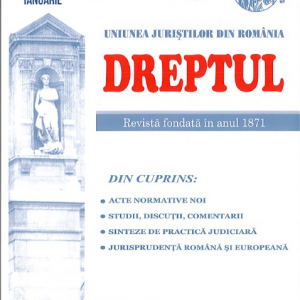 Înalta Curte reține că aprecierea asupra incidenței în cauză a Deciziei nr. 369 din 30 mai 2017 a Curții Constituționale nu încalcă principiul egalității în fața legii ori pe acela al nediscriminării cetățenilor aflați în situații juridice similare și nu reprezintă o denegare de dreptate, ci este consecința principiului aplicării în timp a efectelor juridice pe care o astfel de decizie le dobândește de la momentul publicării ei în Monitorul Oficial al României, fără încălcarea neretroactivității, un alt principiu constituțional. Atunci când hotărârea judecătorească nu se circumscrie sferei de aplicare a unei asemenea decizii nu înseamnă că prin aceasta se încalcă drepturi procesuale fundamentale, ci se procedează la respectarea unor principii și norme imperative, general obligatorii, menite tocmai să asigure garanții procesuale la care recurenta-pârâtă face referire.
Înalta Curte reține că aprecierea asupra incidenței în cauză a Deciziei nr. 369 din 30 mai 2017 a Curții Constituționale nu încalcă principiul egalității în fața legii ori pe acela al nediscriminării cetățenilor aflați în situații juridice similare și nu reprezintă o denegare de dreptate, ci este consecința principiului aplicării în timp a efectelor juridice pe care o astfel de decizie le dobândește de la momentul publicării ei în Monitorul Oficial al României, fără încălcarea neretroactivității, un alt principiu constituțional. Atunci când hotărârea judecătorească nu se circumscrie sferei de aplicare a unei asemenea decizii nu înseamnă că prin aceasta se încalcă drepturi procesuale fundamentale, ci se procedează la respectarea unor principii și norme imperative, general obligatorii, menite tocmai să asigure garanții procesuale la care recurenta-pârâtă face referire. -
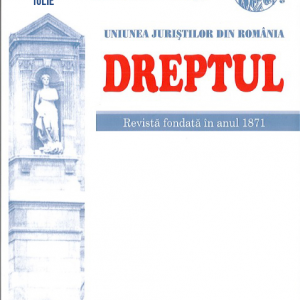 In Romania there is a special regulation (Government Ordinance no. 79/ 2003) on the control and recovery of Community funds and related co-financing funds misused. In the study hereby it is undertaken a presentation and an analysis on the penalty-related legal liability covered by this particular regulation.
In Romania there is a special regulation (Government Ordinance no. 79/ 2003) on the control and recovery of Community funds and related co-financing funds misused. In the study hereby it is undertaken a presentation and an analysis on the penalty-related legal liability covered by this particular regulation. -
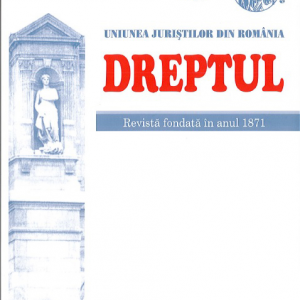 In this article, the author analyzes the legal nature of the Constitutional Court, a political jurisdictional authority of jurisdiction, whose role consists mainly in controlling the constitutionality of laws and of other acts adopted by the Romanian Parliament and by the Government. The Constituent Assembly of 1991 opted for the institutionalization of the European model of constitutional jurisdiction, according to which a body independent in relation to the powers of the State assumes the role of guarantor of the supremacy of the Constitution. The constituent legislators have preferred to abandon the control of the constitutionality of laws enforced by the supreme court, which was established by the Fundamental Law of 1923. In the constitutional architecture of the Romanian State, designed after the change of the political regime at the end of 1989, the Constitutional Court is a political-jurisdictional body whose legal nature derives from the way in which it is organized and structured, as well as from the attributions conferred to it by the Constitution. At the same time, the Constitutional Court also appears as a regulating body of the public authorities with governing powers in the state, which it obliges, through its decisions, to return to the constitutional legality. The author highlights both the political and the judicial nature of the Constitutional Court and shows that there must be a balance between the two essential characteristics of this public authority, in order for it to fulfil its constitutional role in a complete independence and impartiality and not to transform itself into a political tool for solving the relations between powers, especially between the legislative power and the executive power, which should benefit to one or another of the political actors.
In this article, the author analyzes the legal nature of the Constitutional Court, a political jurisdictional authority of jurisdiction, whose role consists mainly in controlling the constitutionality of laws and of other acts adopted by the Romanian Parliament and by the Government. The Constituent Assembly of 1991 opted for the institutionalization of the European model of constitutional jurisdiction, according to which a body independent in relation to the powers of the State assumes the role of guarantor of the supremacy of the Constitution. The constituent legislators have preferred to abandon the control of the constitutionality of laws enforced by the supreme court, which was established by the Fundamental Law of 1923. In the constitutional architecture of the Romanian State, designed after the change of the political regime at the end of 1989, the Constitutional Court is a political-jurisdictional body whose legal nature derives from the way in which it is organized and structured, as well as from the attributions conferred to it by the Constitution. At the same time, the Constitutional Court also appears as a regulating body of the public authorities with governing powers in the state, which it obliges, through its decisions, to return to the constitutional legality. The author highlights both the political and the judicial nature of the Constitutional Court and shows that there must be a balance between the two essential characteristics of this public authority, in order for it to fulfil its constitutional role in a complete independence and impartiality and not to transform itself into a political tool for solving the relations between powers, especially between the legislative power and the executive power, which should benefit to one or another of the political actors. -
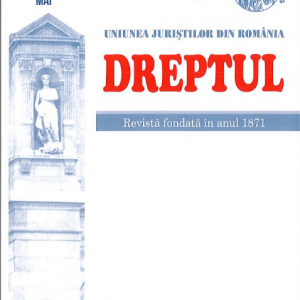 On the strength of Art. 322, item 4 of the current Romanian Civil Procedure Code, the review of a decision that remained final in the appeal court or through the fact that no appeal was submitted against it, as well as the review of a decision issued by a recourse court (when the merits of a case is invoked) may be requested, inter alia, also if “a judge, witness or expert who took part in the lawsuit received a final conviction for any crime regarding a case or if a decision was issued on the strength of a writ that was declared false during or after the lawsuit or if a magistrate received a disciplinary penalty for exercising his office in bad faith or with gross negligence in that case”. The author is discussing in this study the manner in which a civil court must proceed if, at present (for the reasons provided by the criminal law), the perpetration of the abovementioned crimes can no longer be ascertained under a criminal decision.
On the strength of Art. 322, item 4 of the current Romanian Civil Procedure Code, the review of a decision that remained final in the appeal court or through the fact that no appeal was submitted against it, as well as the review of a decision issued by a recourse court (when the merits of a case is invoked) may be requested, inter alia, also if “a judge, witness or expert who took part in the lawsuit received a final conviction for any crime regarding a case or if a decision was issued on the strength of a writ that was declared false during or after the lawsuit or if a magistrate received a disciplinary penalty for exercising his office in bad faith or with gross negligence in that case”. The author is discussing in this study the manner in which a civil court must proceed if, at present (for the reasons provided by the criminal law), the perpetration of the abovementioned crimes can no longer be ascertained under a criminal decision. -
 In this study the authors intended to investigate the procedural rules specific to the judicial control of the acts issued by the public authorities in the matter of restitution of properties taken over by the State during the communist regime, as well as the processual guarantees enjoyed by the persons concerned for the effective exercise of the right to a fair trial and the right to respect the goods regulated by Article 6 paragraph 1 of the European Convention on Human Rights and, respectively, Article 1 of Protocol No 1 to the Convention. During this scientific process, the authors have identified the shortcomings of the legislation in the matter and have formulated de lege ferenda proposals for complying with the Pilot-Judgment of the European Court of Human Rights in the Case Maria Atanasiu and others against Romania, whereby it has been decided that the Romanian State takes measures to guarantee the effective protection of these rights. The proposed legislative amendments have as purpose to re-open access to justice for the eligible persons, in compliance with the requirements of ECHR law, in the cases where public authorities refuse to resolve their requests for restitution of buildings abusively taken over by the State.
In this study the authors intended to investigate the procedural rules specific to the judicial control of the acts issued by the public authorities in the matter of restitution of properties taken over by the State during the communist regime, as well as the processual guarantees enjoyed by the persons concerned for the effective exercise of the right to a fair trial and the right to respect the goods regulated by Article 6 paragraph 1 of the European Convention on Human Rights and, respectively, Article 1 of Protocol No 1 to the Convention. During this scientific process, the authors have identified the shortcomings of the legislation in the matter and have formulated de lege ferenda proposals for complying with the Pilot-Judgment of the European Court of Human Rights in the Case Maria Atanasiu and others against Romania, whereby it has been decided that the Romanian State takes measures to guarantee the effective protection of these rights. The proposed legislative amendments have as purpose to re-open access to justice for the eligible persons, in compliance with the requirements of ECHR law, in the cases where public authorities refuse to resolve their requests for restitution of buildings abusively taken over by the State. -
 In this study, the author fights – with arguments – an opinion that remained isolated in the Romanian civil law doctrine (an opinion according to which art. 32, paragraph 1 of Law no. 18/1991, republished on 5 January 1998, a text according to which certain categories of terms, assigned according to art. 18 paragraph 1, art. 21 and art. 43 of this law, cannot be transferred for 10 years to the company from the beginning of the year following the year in which the registration of the property was made under the penalty of absolute nullity of the deed of transfer would have been abrogated by Laws no. 54/1998 and no. 247/2005).
In this study, the author fights – with arguments – an opinion that remained isolated in the Romanian civil law doctrine (an opinion according to which art. 32, paragraph 1 of Law no. 18/1991, republished on 5 January 1998, a text according to which certain categories of terms, assigned according to art. 18 paragraph 1, art. 21 and art. 43 of this law, cannot be transferred for 10 years to the company from the beginning of the year following the year in which the registration of the property was made under the penalty of absolute nullity of the deed of transfer would have been abrogated by Laws no. 54/1998 and no. 247/2005). -
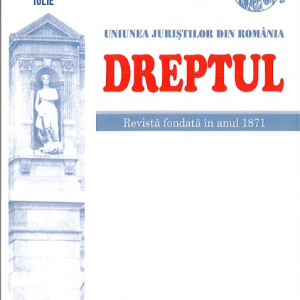 Law no. 230/2007 on the establishment, organization and functioning of the owners’ associations, stipulates in art. 15: “Subject to a 5-day notice, the owner is obliged to accept the access to its apartment or to its space of a representative of the association, when it is necessary to inspect, repair or replace elements in joint ownership, which can be accessed only from the given apartment or space. Emergency situations, when access is possible without notice, shall be exempted”. In the above study, the author initially examines this text in relation to art. 27 of the Constitution of Romania regarding the inviolability of the home. Further on, he examines the requirements imposed by the same text for its legal enforcement; the situations in which the owner’s refusal to allow access – although the legal requirements are met – is an abuse of right and, in the end, other legal possibilities for the association dealing with the owner’s unjustified refusal to allow access.
Law no. 230/2007 on the establishment, organization and functioning of the owners’ associations, stipulates in art. 15: “Subject to a 5-day notice, the owner is obliged to accept the access to its apartment or to its space of a representative of the association, when it is necessary to inspect, repair or replace elements in joint ownership, which can be accessed only from the given apartment or space. Emergency situations, when access is possible without notice, shall be exempted”. In the above study, the author initially examines this text in relation to art. 27 of the Constitution of Romania regarding the inviolability of the home. Further on, he examines the requirements imposed by the same text for its legal enforcement; the situations in which the owner’s refusal to allow access – although the legal requirements are met – is an abuse of right and, in the end, other legal possibilities for the association dealing with the owner’s unjustified refusal to allow access. -
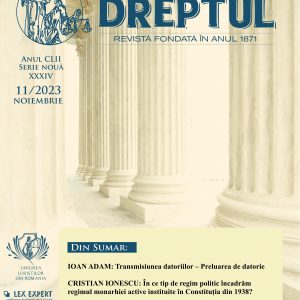
-
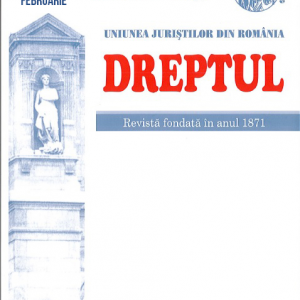 Within the framework of study hereby, the institution of the Romanian President’s immunity under the Criminal Law is subject to review. Observing the constitutional legislator’s option, first there are set under review the material and temporal limits of the procedural immunity. In this context, there are put forth some novel problems such as summoning the President as a witness or the scope of immunity in the case of civil and tort liability. In relation to the substantive law immunity, it is reviewed the rationale of the institution, and then its substantive limits are detailed: the presidential powers are identified, i.e. there are brought to the attention some controversial assumptions such as granting and revoking the conditional pardon, or views expressed by the President in another frame than the official one.
Within the framework of study hereby, the institution of the Romanian President’s immunity under the Criminal Law is subject to review. Observing the constitutional legislator’s option, first there are set under review the material and temporal limits of the procedural immunity. In this context, there are put forth some novel problems such as summoning the President as a witness or the scope of immunity in the case of civil and tort liability. In relation to the substantive law immunity, it is reviewed the rationale of the institution, and then its substantive limits are detailed: the presidential powers are identified, i.e. there are brought to the attention some controversial assumptions such as granting and revoking the conditional pardon, or views expressed by the President in another frame than the official one. -
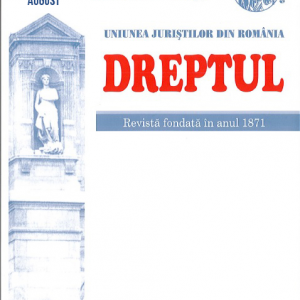 The interest loan is a form of the consumption loan, having as legal grounds, mainly, the provisions of the new Civil Code, art. 2167-2170. This agreement is presumed onerous, the borrower having the obligation to pay, in due time, an amount of money or other type of goods, as interest, representing the equivalent amount of using the borrowed capital. The legal regime of the agreement, including of the generating interest, in its diversity of types, forms the object of the analysis of this study, conducted both according to the common and special provisions of the new Civil Code and in the light of the special legislation, the Government Ordinance no. 13/2011.
The interest loan is a form of the consumption loan, having as legal grounds, mainly, the provisions of the new Civil Code, art. 2167-2170. This agreement is presumed onerous, the borrower having the obligation to pay, in due time, an amount of money or other type of goods, as interest, representing the equivalent amount of using the borrowed capital. The legal regime of the agreement, including of the generating interest, in its diversity of types, forms the object of the analysis of this study, conducted both according to the common and special provisions of the new Civil Code and in the light of the special legislation, the Government Ordinance no. 13/2011. -
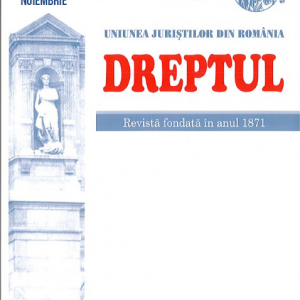 The relatively recently legal notion of imprevision brought under Romanian regulation by the new Civil code that came into force October 1st, 2011, is expected to be subject of numerous specialized analyses in order to clarify the various aspects that make up its identity, characteristics and effectiveness. Following the purpose described here-above, this study aims especially at conjugating the theory of imprevision with the copyright transfer agreement. The article hereafter contains standpoints and de lege ferenda suggestions in relation to the party entitled to institute the legal proceeding relative based upon the imprevision theory, the criteria to be observed in order to adopt a solid legal settlement in this respect, the contracting parties and the court’s role in interpreting and applying the imprevision theory.
The relatively recently legal notion of imprevision brought under Romanian regulation by the new Civil code that came into force October 1st, 2011, is expected to be subject of numerous specialized analyses in order to clarify the various aspects that make up its identity, characteristics and effectiveness. Following the purpose described here-above, this study aims especially at conjugating the theory of imprevision with the copyright transfer agreement. The article hereafter contains standpoints and de lege ferenda suggestions in relation to the party entitled to institute the legal proceeding relative based upon the imprevision theory, the criteria to be observed in order to adopt a solid legal settlement in this respect, the contracting parties and the court’s role in interpreting and applying the imprevision theory. -
 Prin cererea de chemare în judecată adresată Judecătoriei Constanța la data de 11 iunie 2018, contestatorul S.P. în contradictoriu cu intimata Direcția Generală Regională a Finanțelor Publice Galați – Administrația Județeană a Finanțelor Publice Constanța a solicitat instanței să dispună anularea executării silite înseși și a actelor de executare silită subsecvente, inclusiv Somația din data de 30 martie 2018 și Titlul executoriu din data de 30 martie 2018 emise în Dosarul de executare xx, respectiv să oblige intimata la plata cheltuielilor de judecată.
Prin cererea de chemare în judecată adresată Judecătoriei Constanța la data de 11 iunie 2018, contestatorul S.P. în contradictoriu cu intimata Direcția Generală Regională a Finanțelor Publice Galați – Administrația Județeană a Finanțelor Publice Constanța a solicitat instanței să dispună anularea executării silite înseși și a actelor de executare silită subsecvente, inclusiv Somația din data de 30 martie 2018 și Titlul executoriu din data de 30 martie 2018 emise în Dosarul de executare xx, respectiv să oblige intimata la plata cheltuielilor de judecată. -
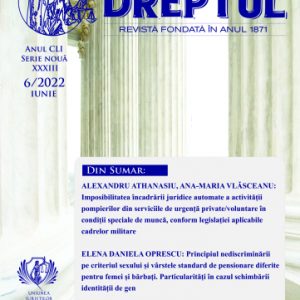 This study aims to promote several solutions to ensure the accurate interpretation and application of certain provisions regulated under Law No 307/2006 on protection against fires, in order to determine whether the work performed by the employed personnel (holder of an employment agreement in private/voluntary emergency services) can be framed (qualified) as performed in special work conditions, under the legislation applicable to military personnel – professional firefighters under the emergency services.
This study aims to promote several solutions to ensure the accurate interpretation and application of certain provisions regulated under Law No 307/2006 on protection against fires, in order to determine whether the work performed by the employed personnel (holder of an employment agreement in private/voluntary emergency services) can be framed (qualified) as performed in special work conditions, under the legislation applicable to military personnel – professional firefighters under the emergency services. -
 Achitare persoană fizică autorizată (avocat) pentru infracțiunea de evaziune fiscală. Nedepunerea în termen a declarației fiscale 200 pentru o perioadă de doi ani nu constituie infracțiune, ci contravenție. Sumele obținute din activități economice, dar declarate cu întârziere sau nedeclarate, pot fi impozitate cu ocazia controlului fiscal, în cazul în care documentele primare justificative, respectiv chitanțele și facturile, sunt întocmite, sunt disponibile și pot fi verificate. Nedepășirea plafonului pentru obligativitatea înregistrării contribuabilului ca plătitor de TVA poate fi dovedită prin mijloace de probă.
Achitare persoană fizică autorizată (avocat) pentru infracțiunea de evaziune fiscală. Nedepunerea în termen a declarației fiscale 200 pentru o perioadă de doi ani nu constituie infracțiune, ci contravenție. Sumele obținute din activități economice, dar declarate cu întârziere sau nedeclarate, pot fi impozitate cu ocazia controlului fiscal, în cazul în care documentele primare justificative, respectiv chitanțele și facturile, sunt întocmite, sunt disponibile și pot fi verificate. Nedepășirea plafonului pentru obligativitatea înregistrării contribuabilului ca plătitor de TVA poate fi dovedită prin mijloace de probă. -
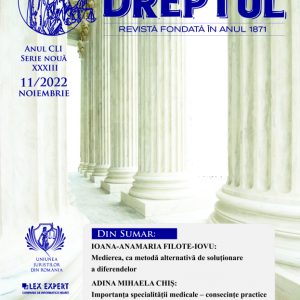 The purpose of this article is to clarify the importance of respecting the limits of the medical specialty, the consequences arising from this, in terms of the nature of medical expertise. Nowadays, forensic expertise continues to be approached from an obsolete perspective, without detecting its limits in medical or legal matters. This article aims to analyze the relevant legislation regarding the limits and implications of medical specialties. Despite the abundance of specialized works in the field, it is still difficult to clarify the object of forensic expertise. The purpose of our analysis is to reveal the nature of the expertise that is carried out in trials where medical malpractice is being examined, whether it is the negligence of the doctor or the fault of the medical or pharmaceutical unit.
The purpose of this article is to clarify the importance of respecting the limits of the medical specialty, the consequences arising from this, in terms of the nature of medical expertise. Nowadays, forensic expertise continues to be approached from an obsolete perspective, without detecting its limits in medical or legal matters. This article aims to analyze the relevant legislation regarding the limits and implications of medical specialties. Despite the abundance of specialized works in the field, it is still difficult to clarify the object of forensic expertise. The purpose of our analysis is to reveal the nature of the expertise that is carried out in trials where medical malpractice is being examined, whether it is the negligence of the doctor or the fault of the medical or pharmaceutical unit. -
 This study addresses the problems determined by the fact that in the current Romanian criminal processual legislation there is a sign of equivalence between the moment of pronouncing the judgment and the moment of reading the minutes which contains only the operative part of the judgment. This aspect determines certain consequences that affect the rights of the persons who, in one quality or another, are involved in that criminal trial, resulting even in the execution of a minutes and in the conditional release before the reasoning of the appeal decision. For all these reasons, the study proposes that the reasoning of the judgment should be made before the pronouncement, which would remove all the above shortcomings and would strengthen the confidence of the litigants in the act of justice.
This study addresses the problems determined by the fact that in the current Romanian criminal processual legislation there is a sign of equivalence between the moment of pronouncing the judgment and the moment of reading the minutes which contains only the operative part of the judgment. This aspect determines certain consequences that affect the rights of the persons who, in one quality or another, are involved in that criminal trial, resulting even in the execution of a minutes and in the conditional release before the reasoning of the appeal decision. For all these reasons, the study proposes that the reasoning of the judgment should be made before the pronouncement, which would remove all the above shortcomings and would strengthen the confidence of the litigants in the act of justice. -
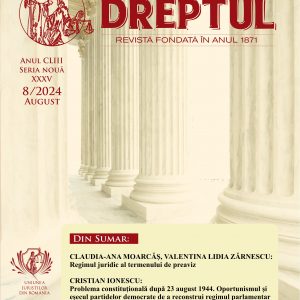
-

-
 The Treaty on European Union includes not only the core of the Community rules, but also references to the necessity to bring some amendments to the national legislation of Member States in accordance with these rules. Complying with this requirement, the Romanian legislator constantly brings amendments which, in criminal matters, involve an interdisciplinary approach, imposing compliance with general principles of law and with principles specific for the protection of human rights and for European Union law.
The Treaty on European Union includes not only the core of the Community rules, but also references to the necessity to bring some amendments to the national legislation of Member States in accordance with these rules. Complying with this requirement, the Romanian legislator constantly brings amendments which, in criminal matters, involve an interdisciplinary approach, imposing compliance with general principles of law and with principles specific for the protection of human rights and for European Union law. -
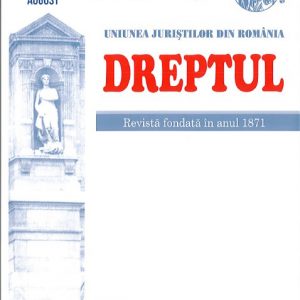 In this study, the author analyzes the practical implications of the amendments brought to the Civil Procedure Code by the Government Emergency Ordinance No 1/2016, following the admission of the plea of unconstitutionality of the provisions of Article 666 of the Civil Procedure Code by the Decision of the Constitutional Court No 895/2015. After a brief historical presentation of the legislative events that have led to the current situation regarding the approval of enforcement, the author, by examining the effects of the Decision of the Constitutional Court No 895/2015 and of the Government Emergency Ordinance No 1/2016, identifies the categories of situations that may arise in the practice of enforcement.
In this study, the author analyzes the practical implications of the amendments brought to the Civil Procedure Code by the Government Emergency Ordinance No 1/2016, following the admission of the plea of unconstitutionality of the provisions of Article 666 of the Civil Procedure Code by the Decision of the Constitutional Court No 895/2015. After a brief historical presentation of the legislative events that have led to the current situation regarding the approval of enforcement, the author, by examining the effects of the Decision of the Constitutional Court No 895/2015 and of the Government Emergency Ordinance No 1/2016, identifies the categories of situations that may arise in the practice of enforcement. -
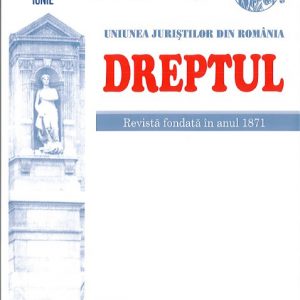 The new Fiscal Code and the new Fiscal Procedure Code harmonized with the European Union legislation have brought significant mutations in the development of the relations of fiscal law and of fiscal processual law between the public tax authorities and the taxpayers/payers. These relations of fiscal law and of processual fiscal law have as their primary foundation the fiscal administrative act, which underlies the entire edifice of the fiscal matter. Starting from these desiderata, this study aims at analyzing several aspects regarding the implications which the new regulatory framework in fiscal matters has brought in the field of adoption of some fiscal administrative acts, emphasizing, at the same time, the distinction which must be made between the fiscal administrative acts and the administrative acts whereby budgetary claims are individualized.
The new Fiscal Code and the new Fiscal Procedure Code harmonized with the European Union legislation have brought significant mutations in the development of the relations of fiscal law and of fiscal processual law between the public tax authorities and the taxpayers/payers. These relations of fiscal law and of processual fiscal law have as their primary foundation the fiscal administrative act, which underlies the entire edifice of the fiscal matter. Starting from these desiderata, this study aims at analyzing several aspects regarding the implications which the new regulatory framework in fiscal matters has brought in the field of adoption of some fiscal administrative acts, emphasizing, at the same time, the distinction which must be made between the fiscal administrative acts and the administrative acts whereby budgetary claims are individualized. -
 The following codes coexist at this moment in Romania: the Civil Procedure Code (issued in 1865, republished in 1948, subsequently supplemented and amended on numerous occasions), the Family Code (issued in 1954) and the Civil Code (issued in 1865), both of them were amended and supplemented by the new Civil Code and by the new Civil Procedure Code (published in 2009, respectively in 2010), but have not come into force yet. Under the circumstances, Law No. 202/2010 regarding certain measures to accelerate disputes resolution was enacted in October 2010; this law takes over a series of provisions from the new (civil and civil procedure) Codes. In this context, the author, by means of the above study, makes a thorough analysis of the impact of Law No. 202/2010 (mentioned hereinabove) on the notary procedures (regulated under Law No. 35/1995 regarding notaries public and notary activity, subsequently amended and supplemented in a successive manner) both at present, and from the perspective of the new (civil and civil procedure) Codes.
The following codes coexist at this moment in Romania: the Civil Procedure Code (issued in 1865, republished in 1948, subsequently supplemented and amended on numerous occasions), the Family Code (issued in 1954) and the Civil Code (issued in 1865), both of them were amended and supplemented by the new Civil Code and by the new Civil Procedure Code (published in 2009, respectively in 2010), but have not come into force yet. Under the circumstances, Law No. 202/2010 regarding certain measures to accelerate disputes resolution was enacted in October 2010; this law takes over a series of provisions from the new (civil and civil procedure) Codes. In this context, the author, by means of the above study, makes a thorough analysis of the impact of Law No. 202/2010 (mentioned hereinabove) on the notary procedures (regulated under Law No. 35/1995 regarding notaries public and notary activity, subsequently amended and supplemented in a successive manner) both at present, and from the perspective of the new (civil and civil procedure) Codes. -
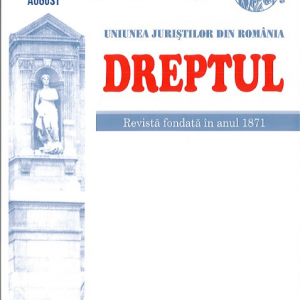 When the court of judicial review is vested with the settlement of the recourse against the court order under which the legal and the solid nature of the preventive arrest has been reviewed ex officio according to the procedure set forth by art.3001 of the Code of Criminal Procedure, the recourse should be settled before the expiry of the preventive arrest period, taken or extended by the judge subsequently. This review deadline is a bar period, not a recommendation one. In practice, it is found that the court decides in relation to the review of the legal and the solid nature of the preventive arrest upon the receipt of the file, many times on the last or penultimate day of the 30-day deadline of the preventive arrest. This situation occurs either due to the non-observance of the 5-day deadline by the prosecutor, or by the court itself, and consequently the court of appeal decides within a period of a few days following the expiry of the 30-day period.
When the court of judicial review is vested with the settlement of the recourse against the court order under which the legal and the solid nature of the preventive arrest has been reviewed ex officio according to the procedure set forth by art.3001 of the Code of Criminal Procedure, the recourse should be settled before the expiry of the preventive arrest period, taken or extended by the judge subsequently. This review deadline is a bar period, not a recommendation one. In practice, it is found that the court decides in relation to the review of the legal and the solid nature of the preventive arrest upon the receipt of the file, many times on the last or penultimate day of the 30-day deadline of the preventive arrest. This situation occurs either due to the non-observance of the 5-day deadline by the prosecutor, or by the court itself, and consequently the court of appeal decides within a period of a few days following the expiry of the 30-day period. -
 Perioada dintre rămânerea definitivă a hotărârii de condamnare și reluarea procesului penal, ca urmare a admiterii redeschiderii procesului penal în cazul judecării în lipsă a persoanei condamnate, este luată în considerare pentru stabilirea împlinirii termenului de prescripției. (Judecătoria Târgu Jiu, Sentința penală nr. 2141/2017, definitivă prin neapelare – nepublicată – cu notă critică)
Perioada dintre rămânerea definitivă a hotărârii de condamnare și reluarea procesului penal, ca urmare a admiterii redeschiderii procesului penal în cazul judecării în lipsă a persoanei condamnate, este luată în considerare pentru stabilirea împlinirii termenului de prescripției. (Judecătoria Târgu Jiu, Sentința penală nr. 2141/2017, definitivă prin neapelare – nepublicată – cu notă critică)
